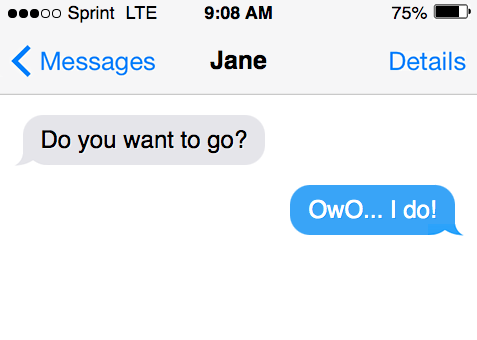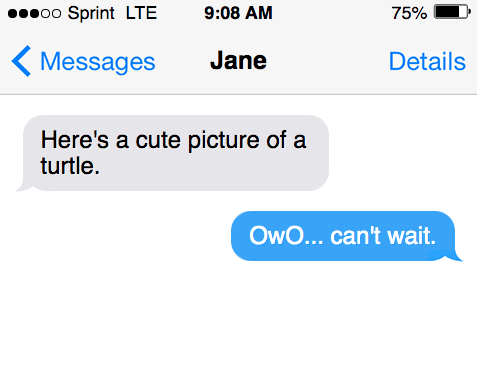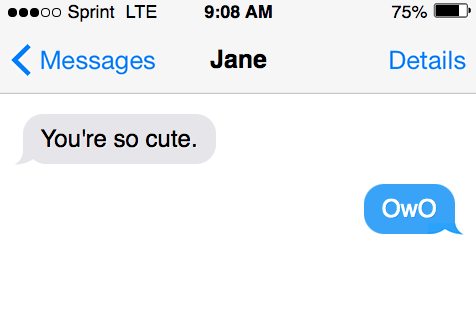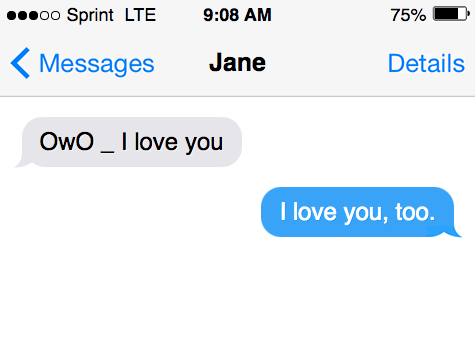What does “OWO” mean? When someone says, “OWO” over text message or in an internet chat, what does it mean? This abbreviation is more unique than other internet slang terms. It is used to show expression.
Learn what “OWO” means in this short guide…
“OWO” meaning and definition
“OWO” stands for nothing. It is used to make a small picture of a cute face. With the “O” letters being the eyes (in a shocked or surprised fashion) and the “W” being the nose of the face. If used correctly, “OwO” looks like a small face.
Technically, the emoticon “OwO” is used to create a response. Making this a weird acronym when used in a conversation. What does “OWO” stand for? Truly, nothing.

If you look at the word, the “O” can certainly represent eyes and the “w” can look like a type of nose.
Capitalization
Typically, the “OwO” abbreviation has a unique capitalization method. With the “O” letters being capitalized and the “W” letter being lowercase.
Correct: OwO
Incorrect: owO
Usages
In most cases, the “OwO” abbreviation is used amongst furry enthusiasts. These are communities of people who associate with animals. The “OwO” abbreviation can look like a type of anime face.
Social media: Instagram, TikTok, Snapchat, and Twitter.
Internet forums: Discord, chat rooms, and other destinations.

Intentions (synonyms)
- Cute
- Smiling
- Appreciative
- Warm
- Meaningful
- Amazed
- Gleeful
- Cheerful
Formality
This emoticon should not get used in business settings. It is a highly informal emoticon that can come across as childish if used in business settings.
Other meanings
These meanings, while far less common, can still have a place for the abbreviation “OWO”:
- Old World Order (various organizations)
- Outdoor Writers of Ohio
- Obsolete When Out (Car Slang)
- One Woman Operation
- Origin Worlds Online (gaming community site)
- On Work Order
- Operations Workforce Optimization
History of “OWO”
Part of the first wave of emoticons used on the internet were those that looked like faces. Urban Dictionary dates the “OwO” emoticon back to 2016. While gaining in popularity around 2018. In most cases, a person using the abbreviation “OwO” is intending to communicate the emoticon to friends, rather than other associations.
It is used to convey emotion, intrigue, shock, and cuteness.

“OWO” getting used in a conversation
“OwO” can get used in conversations of all types. Here are a few examples.
Example one
Friend 1: “OwO, what’s this? I just noticed that you sent me this a few days ago.”
Friend 2: “Yes, check it out. It’s so cute!”
In this conversation, the first friend is using “OwO” to be a sign of intrigue. This is a cute and happy response from a friend. It represents positive emotions and a generally positive response.
Example two
Friend 1: “I just sent you a picture of a really cute furry animal.”
Friend 2: “OwO!”
The second example shows the emoticon getting used on its own, without any other words around it. The abbreviation can get written on its own, used as a way to express that the person is excited.

Similar short forms and abbreviations
Other similar short forms and abbreviations:
UwU: A very similar expression to “UwU,” used in the furry community. “UwU” also represents a face and an emotional response from one person to another. The “U” letters are intended to be eyes, replacing the “O” letters in the emoticon “OwO.”
Sources
- OwO – Urban Dictionary
- Furry fandom – Wikipedia
- What’s a Furry? – Furscience
- Uwu definition and meaning | Collins English Dictionary
- OWO – What does OWO stand for? The Free Dictionary
Inside this article
Fact checked:
Content is rigorously reviewed by a team of qualified and experienced fact checkers. Fact checkers review articles for factual accuracy, relevance, and timeliness. Learn more.
Core lessons
Glossary
- Abstract Noun
- Accusative Case
- Anecdote
- Antonym
- Active Sentence
- Adverb
- Adjective
- Allegory
- Alliteration
- Adjective Clause
- Adjective Phrase
- Ampersand
- Anastrophe
- Adverbial Clause
- Appositive Phrase
- Clause
- Compound Adjective
- Complex Sentence
- Compound Words
- Compound Predicate
- Common Noun
- Comparative Adjective
- Comparative and Superlative
- Compound Noun
- Compound Subject
- Compound Sentence
- Copular Verb
- Collective Noun
- Colloquialism
- Conciseness
- Consonance
- Conditional
- Concrete Noun
- Conjunction
- Conjugation
- Conditional Sentence
- Comma Splice
- Correlative Conjunction
- Coordinating Conjunction
- Coordinate Adjective
- Cumulative Adjective
- Dative Case
- Determiner
- Declarative Sentence
- Declarative Statement
- Direct Object Pronoun
- Direct Object
- Diction
- Diphthong
- Dangling Modifier
- Demonstrative Pronoun
- Demonstrative Adjective
- Direct Characterization
- Definite Article
- Doublespeak
- False Dilemma Fallacy
- Future Perfect Progressive
- Future Simple
- Future Perfect Continuous
- Future Perfect
- First Conditional
- Irregular Adjective
- Irregular Verb
- Imperative Sentence
- Indefinite Article
- Intransitive Verb
- Introductory Phrase
- Indefinite Pronoun
- Indirect Characterization
- Interrogative Sentence
- Intensive Pronoun
- Inanimate Object
- Indefinite Tense
- Infinitive Phrase
- Interjection
- Intensifier
- Infinitive
- Indicative Mood
- Participle
- Parallelism
- Prepositional Phrase
- Past Simple Tense
- Past Continuous Tense
- Past Perfect Tense
- Past Progressive Tense
- Present Simple Tense
- Present Perfect Tense
- Personal Pronoun
- Personification
- Persuasive Writing
- Parallel Structure
- Phrasal Verb
- Predicate Adjective
- Predicate Nominative
- Phonetic Language
- Plural Noun
- Punctuation
- Punctuation Marks
- Preposition
- Preposition of Place
- Parts of Speech
- Possessive Adjective
- Possessive Determiner
- Possessive Case
- Possessive Noun
- Proper Adjective
- Proper Noun
- Present Participle
- Prefix
- Predicate



